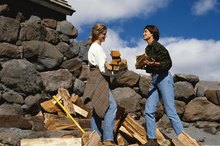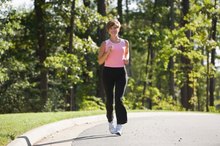What does fact checked mean?
At Healthfully, we strive to deliver objective content that is accurate and up-to-date. Our team periodically reviews articles in order to ensure content quality. The sources cited below consist of evidence from peer-reviewed journals, prominent medical organizations, academic associations, and government data.
The information contained on this site is for informational purposes only, and should not be used as a substitute for the advice of a professional health care provider. Please check with the appropriate physician regarding health questions and concerns. Although we strive to deliver accurate and up-to-date information, no guarantee to that effect is made.
How Many Calories to Eat When Running 7 Miles?
Running develops your cardiovascular system and burns a significant number of calories. For those running for sport, providing your body with adequate calories is important for performance. Limiting calorie intake is key for those trying to lose body fat.
Considerations
The number of calories you should consume every day if you run seven miles depends on your goals. If you’re trying to lose weight, you’ll want to eat fewer calories than you burn per day. If you’re trying to maintain your current weight, you’ll want to consume the same number of calories that you burn. The total number of calories you burn everyday is the sum of the calories burned during rest and the calories burned during your running workout and other activities.
- The number of calories you should consume every day if you run seven miles depends on your goals.
- If you’re trying to maintain your current weight, you’ll want to consume the same number of calories that you burn.
Metabolism
How Many Calories Are Necessary Per Day to Lose 60 Pounds?
Learn More
The number of calories you naturally burn throughout the day is called your metabolic rate. You can calculate this number by using an equation provided by BMI Calculator 2. A man calculates his basal metabolic rate by using this equation: 66 + (6.23 X weight in lbs) + (12.7 X height in inches) – (6.8 X age in years). A woman calculates her rate by using this formula: 655 + (4.35 X weight in lbs) + (4.7 X height in inches) – (4.7 X age in years).
Calories Burned Running
To determine the total number of calories you burn, add your metabolic rate value to the number of calories you burn from running. The number of calories you burn when running seven miles depends on your speed and the time it takes you to complete the run. A 150 lbs. person that runs at a pace of five miles per hour and thus will take 84 minutes to complete a seven mile run, will burn about 817 calories. If that person runs eight miles per hour and thus takes 56 minutes to complete a seven mile run, he will burn about 920 calories.
- To determine the total number of calories you burn, add your metabolic rate value to the number of calories you burn from running.
- The number of calories you burn when running seven miles depends on your speed and the time it takes you to complete the run.
Related Articles
References
- MedlinePlus: Exercise and Physical Fitness
- BMI Calculator: BMR Formula
- MedlinePlus: Exercise and Age
- Calorie Burners: Activities that turn up the heat. American Council on Exercise
- Li SSW, Chan OHT, Ng TY, et al. Gender Differences in Energy Expenditure During Walking With Backpack and Double-Pack Loads. Hum Factors. 2018;:18720818799190. doi:10.1177/0018720818799190
- Chang CH, Lin KC, Ho CS, Huang CC. Accuracy of the energy expenditure during uphill exercise measured by the Waist-worn ActiGraph. J Exerc Sci Fit. 2019;17(2):62-66. doi:10.1016/j.jesf.2019.01.003
- Champagne CM, Broyles ST, Moran LD, et al. Dietary intakes associated with successful weight loss and maintenance during the Weight Loss Maintenance trial. J Am Diet Assoc. 2011;111(12):1826-35. doi:10.1016/j.jada.2011.09.014
- LAYDEN, J. D., PATTERSON, M. J., & NIMMO, M. A. (2002). Effects of reduced ambient temperature on fat utilization during submaximal exercise. Medicine & Science in Sports & Exercise, 34(5), 774–779. doi:10.1097/00005768-200205000-00008
- Li, S. S. W., Chan, O. H. T., Ng, T. Y., Kam, L. H., Ng, C. Y., Chung, W. C., & Chow, D. H. K. (2018). Gender Differences in Energy Expenditure During Walking With Backpack and Double-Pack Loads. Human Factors: The Journal of the Human Factors and Ergonomics Society, 61(2), 203–213. doi:10.1177/0018720818799190
- Michael N. Sawka,1 C. Bruce Wenger, Andrew J. Young, and Kent B. Pandolf. Physiological Responses to Exercise in the Heat. Copyright 1993 by the National Academy of Sciences. All rights reserved.
- Morio, B., Beaufrere, B., Montaurier, C., Verdier, E., Ritz, P., Fellmann, N., … Vermorel, M. (1997). Gender differences in energy expended during activities and in daily energy expenditure of elderly people. American Journal of Physiology-Endocrinology and Metabolism, 273(2), E321–E327. doi:10.1152/ajpendo.1997.273.2.e321
- Yue, A. S. Y., Woo, J., Ip, K. W. M., Sum, C. M. W., Kwok, T., & Hui, S. S. C. (2007). Effect of age and gender on energy expenditure in common activities of daily living in a Chinese population. Disability and Rehabilitation, 29(2), 91–96. doi:10.1080/09638280600662232
- Ainsworth, B.; Haskell, W.; Herrmann, S. et al. Compendium of Physical Activities: A Second Update of Codes and MET Values. Med Sci Sports Exercise. 2011;43:1575. DOI: 10.1249/MSS.0b013e31821ece12.
- American Council on Exercise. (2009) Fit Facts - Calories Burners: Activities That Turn Up the Heat. San Diego, California: American Council on Exercise.
Writer Bio
Kim Nunley has been screenwriting and working as an online health and fitness writer since 2005. She’s had multiple short screenplays produced and her feature scripts have placed at the Austin Film Festival. Prior to writing full-time, she worked as a strength coach, athletic coach and college instructor. She holds a master's degree in kinesiology from California State University, Fullerton.









